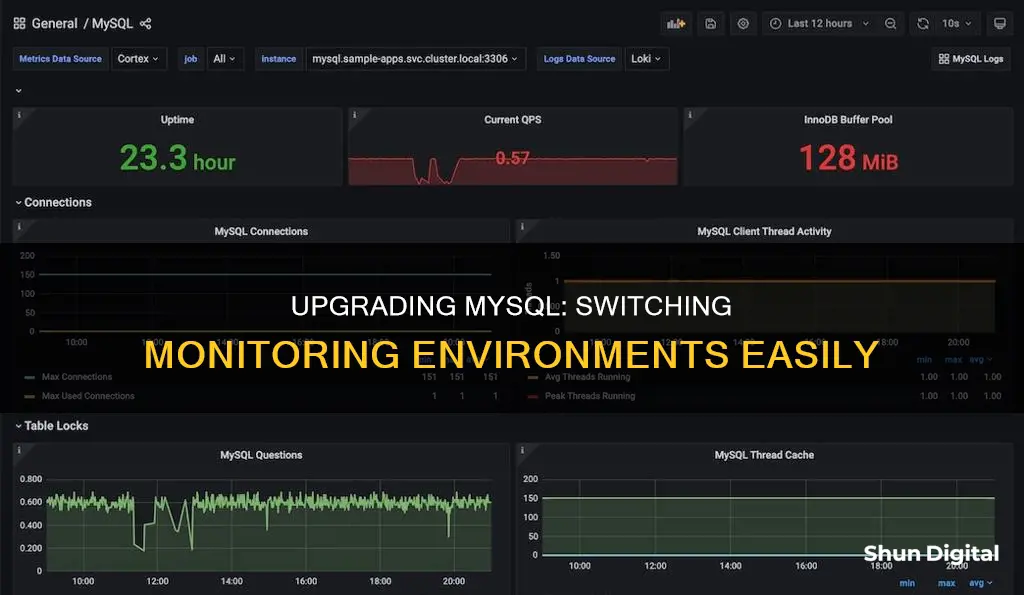
MySQL is a popular open-source database management system. Users can switch to a new user from the MySQL console by creating a new user and providing them with the necessary grants. This can be done by using the 'system' command, which allows users to execute shell commands like 'ls, cd, mv, mkdir', and login as a different user. Alternatively, the 'connect' command can be used to reconnect to the server with a different user and database.
What You'll Learn
- How to use the 'connect' command to switch MySQL users?
- How to use the 'delimiter' command to set a statement delimiter?
- How to use the 'system' command to execute a system shell command?
- How to use the 'use' command to select another database?
- How to use the 'source' command to execute an SQL script file?

How to use the 'connect' command to switch MySQL users
To switch users in MySQL, you need to open a new session with the desired user. You can do this by ending the current session and then starting a new one with the following command:
Mysql -uUSER -p DATABASE
Here, `USER` is the name of the new user and `DATABASE` is the database to switch to when you log in. The `-p` flag indicates that you will be prompted to enter a password.
Alternatively, you can use the SYSTEM command to execute a shell command from the MySQL prompt and switch users:
MySQL> SYSTEM mysql -u user -p
Note that this method will not switch you back to the root user when you exit/quit.
Pioneer DJ Studio Monitors: Immersive Audio Experience
You may want to see also

How to use the 'delimiter' command to set a statement delimiter
The DELIMITER command in MySQL is used to change the default delimiter, which is a semicolon (;). This is particularly useful when you want to execute multiple SQL statements or define stored procedures, functions, or triggers that contain multiple statements. By changing the delimiter, you can treat a group of statements as a single unit and avoid ambiguity.
Here's how you can use the DELIMITER command to set a statement delimiter:
Redefine the Delimiter: Use the DELIMITER command followed by the desired delimiter character or string. For example, to change the delimiter to //, you would use:
Sql
DELIMITER //
Use the New Delimiter: After changing the delimiter, you can use the new delimiter to end statements. For example:
Sql
SELECT * FROM customers //
SELECT * FROM products //
Revert to the Default Delimiter: To go back to using the semicolon (;) as the delimiter, use the following statement:
Sql
DELIMITER ;
It's important to note that the DELIMITER command is specific to the MySQL client program or command-line interface and is not a regular MySQL language feature. It won't work if you're using a programming language API to interact with MySQL.
Additionally, when choosing a custom delimiter, avoid using the backslash (\) character, as it is the escape character in MySQL.
Choosing a Monitor: Color Accuracy Matters
You may want to see also

How to use the 'system' command to execute a system shell command
To execute a system shell command from within a MySQL client, you can use the system command. This enables you to execute the given command using your default command interpreter.
For example, to switch to a different user, you can use the following command:
System mysql -u username -p
This will prompt you to enter the password for the specified username. After successfully logging in, you can verify the current user by using the following command:
Select user();
It is important to note that the system command is only available for Unix-based systems.
A Simple Guide to Removing the Base of Your HP Monitor
You may want to see also

How to use the 'use' command to select another database
To select a database in MySQL, you can use the SQL 'USE' statement. This allows you to perform operations on the selected database, such as creating tables, adding data, and deleting information.
The syntax for the 'USE' statement is as follows:
Sql
USE DatabaseName;
Here, 'DatabaseName' is a placeholder for the name of the database you want to use. For example, if you have a database named 'World', you would use the following command:
Sql
USE World;
You will then see the message "Database changed" if the database has been selected successfully.
You can also select a database when connecting to MySQL by specifying the database name:
Sql
Mysql -u user -p DatabaseName
Alternatively, you can use a client program to select a database in MySQL. Here is an example of how to do this in Python:
Python
Import mysql.connector
Creating the connection object
Connection = mysql.connector.connect(
Host="localhost",
User="root",
Password="password"
Standard Monitor Size: Understanding 1366x768 Resolutions
You may want to see also

How to use the 'source' command to execute an SQL script file
To execute an SQL script file using the source command, follow these steps:
- Create a text file containing the SQL statements you wish to execute. Save this file with a .sql extension, for example, "myScript.sql".
- Open a command prompt window or terminal.
- Navigate to the directory where your SQL script file is saved.
- If you are using MySQL, invoke the MySQL client by typing "mysql" followed by the name of the database you want to use. For example, "mysql myDatabase".
- Once you are in the MySQL client, use the source command to execute your SQL script file:
Sql
Source myScript.sql;
Alternatively, you can use the "\. command", which does the same thing:
Sql
\. myScript.sql;
Note that if you place a "USE db_name" statement as the first statement in your SQL script file, you don't need to specify the database name on the command line when invoking the MySQL client.
Also, keep in mind that the source command is specific to SQL scripts and will not work with other types of files. If you want to execute commands or SQL statements from a non-SQL script file, you might need to use a different approach or tool.
Monitoring Staff Performance: Meeting Organizational Standards
You may want to see also







